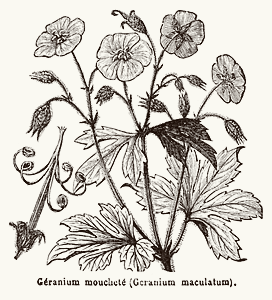Geranium

GERANIUM s. (gr. geranos, crane). Bot. genus of geraniaceae, which includes approximately 70 species of herbaceous plants, cultivated for the most part in pleasure gardens, and remarkable by the shape of the seed-head, which looks like the bill of a crane.
– The name geranium is commonly attributed to plants of the genus pelargonium.
– The main French species are: the hedgerow cranesbill (geranium Pyrenaicum), with purple or light crimson flowers; the shining geranium (geranium lucidum), glabrous, with pink flowers; the round-leaved cranesbill (geranium rotundifolia), with a pubescent calyx; the bloody cranesbill (geranium sanguineum), one of the most beautiful indigenous species, with large flowers of a blood-red colour; herb-robert (geranium robertianum), with small red flowers, commun in rocky places. the following are particularly grown in gardens: the french cranesbill (geranium Endresii), a lovely Pyrenean species with large pink flowers; the rock cranesbill (geranium macrorhizum), originating in Italy, with flowers of a beautiful pink colour; the pencilled cranesbill (geranium striatum), from Italy, with white, bilobed petals bearing crimson veins; the caucasian cranesbill (geranium ibericum), from Caucasus, with flowers ranging from purple to a beautiful azure blue. North America has the spotted cranesbill (geranium maculatum). All these plants grow in open ground; they are multiplied by sowing seeds in the spring and in the summer; by splitting in autumn.
Extract from the Trousset encyclopedia, 1886 – 1891.
Tags: flowers, geraniaceae, plants, Trousset encyclopedia


